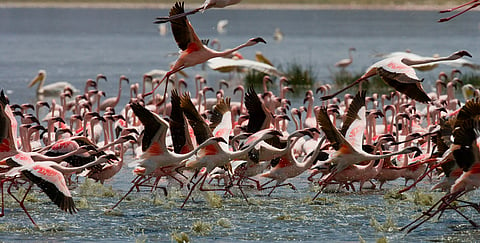Follow the birds, and you’ll understand what wetlands are worth
Wetlands are crucial for biodiversity, supporting migratory birds like the Bar-tailed Godwit, which relies on them for survival during its long journey.
Despite their importance, wetlands are rapidly disappearing, threatening ecosystems and human livelihoods.
Urgent conservation efforts and innovative funding are needed to protect these vital habitats and ensure their continued benefits for both nature and people.
Each year, the Bar-tailed Godwit flies more than 10,000 kilometers nonstop from Alaska to New Zealand, crossing the Pacific without landing once, taking between six and eight days. It relies on a chain of wetlands to rest and refuel before making the return journey north. If just one of those sites disappears, the bird’s journey—and its survival—could come to an end.
From rivers, lakes and swamps, to mudflats, estuaries and floodplains, wetlands have supported human and animal life for millennia. They provide clean water, store carbon, prevent or reduce the impact of floods, and provide critical habitat. Despite covering 6 per cent of the Earth’s surface, wetlands are home to 40 per cent of global biodiversity and support the livelihoods of four billion people around the world. For billions of migratory birds, wetlands are vital stopovers, providing places to feed and breed during their long and arduous migrations.
Yet wetlands are vanishing fast, making them one of the planet’s most threatened ecosystems. According to the recently released Global Wetland Outlook 2025, the world has lost 22 per cent of these critical ecosystems since the 1970s — equivalent to more than half a billion football pitches. This loss continues, driven by various factors including agricultural expansion, pollution, urbanisation, industrial development, and climate change. One-fifth of the world’s remaining wetlands could disappear by 2050 if current trends continue, resulting in the loss of US$39 trillion in ecosystem services.
When these habitats are lost or degraded, bird populations plummet and disrupt ecological balance, warning us of even the greater environmental threats that loom ahead.
Other ecosystems such as forests receive recognition and protection that wetlands do not. Their ecological and societal importance deserves to be heard, but the lack of awareness about the link between wetlands and the essential services they provide often leaves them out in the cold. Alongside the complexity associated with quantifying their economic value, weak wetland protection laws have allowed wetland degradation to continue.
We must show wetlands’ true worth for the people and animals that depend on them. That means going beyond abstract figures to communicate the benefits they provide, which will bolster efforts to improve wetland management and wise use, and establish the right legal framework to ensure their protection. It will also help unlock funding, strengthen local stewardship, and raise wetlands on political agendas.
Mobilising adequate funding for conservation and restoration must be a priority. Biodiversity loss and ecosystem collapse now rank among the top risks to the global economy. Yet conservation funding accounts for just 0.25 per cent of global GDP, with an annual gap of an astounding $700 billion. World leaders have pledged to close this gap and some countries are stepping up. Others can join them by tapping into innovative finance tools—like debt-for-nature swaps where debt relief can be provided in exchange for wetlands conservation commitments, green and blue bonds, carbon markets, Payments for Ecosystem Services (PES) schemes, and biodiversity credits.
Implementing conservation initiatives at scale can go a long way in protecting wetlands. One promising model is the flyways approach. It protects and restores wetlands along bird migration routes that span borders and regions. An example of this is in the East Asian- Australasian Flyway, one of the world’s eight major bird migration superhighways. Stretching from Siberia and Alaska to Australia and New Zealand, the flyway connects a chain of coastal wetlands spanning 20+ countries, providing vital habitats where some 50 million waterbirds of over 200 different species stop to feed, and rest before continuing on the next leg of their journey.
In 2021, BirdLife, in collaboration with the Asian Development Bank and East Asian-Australasian Flyway Partnership, launched the $3-billion Regional Flyway Initiative (RFI). The RFI aims to restore and protect the more than 50 key wetland sites along the flyway, which support not only birds, but the livelihoods of millions of people through sustainable fisheries and agriculture. Such models are not isolated success stories; they can be replicated across flyways globally.
As the world prepares to convene in Zimbabwe from July 23-31, 2025, for the 15th meeting of the Conference of the Contracting Parties to the Convention on Wetlands (COP15) it is an opportunity to raise ambition and double down on existing political commitments to protect our wetlands. This includes among other things, adoption of the Convention’s Fifth Strategic Plan (2025-2034) to guide wise use of wetlands, integrate wetlands conservation into National Plans, and bridge the financing gap to support wetlands conservation.
When we lose a wetland, we break a link in the chain that holds life together—from the Bar-tailed Godwit in flight to the people who depend on wetlands for water, food, and protection. The world cannot afford to let that chain collapse.
Musonda Mumba is the Secretary General of the Ramsar Convention. Martin Harper is the Chief Executive Officer (CEO), BirdLife International
Views expressed are the authors’ own and don’t necessarily reflect those of Down To Earth

